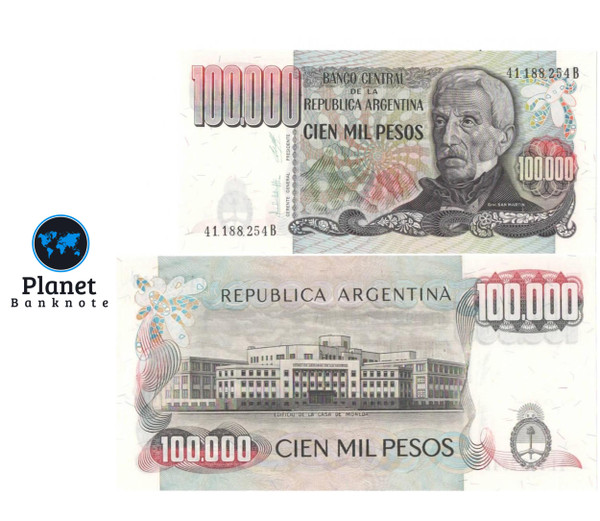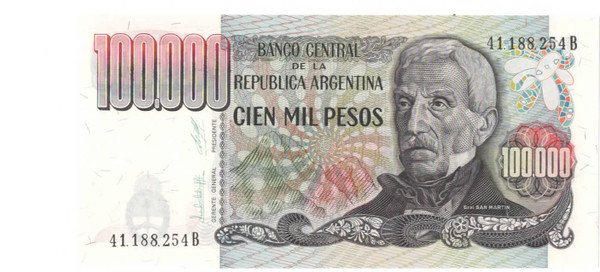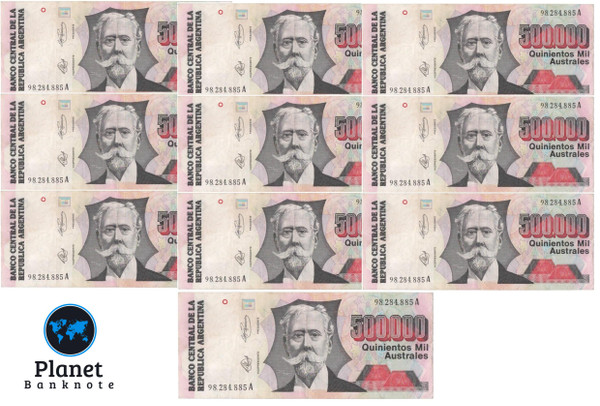-


1979–1981 Argentina 100,000 Pesos Banknote P-308b San Martín UNC Crisp Hyperinflation Era
Inc. TaxInc. TaxRRP: Inc. Tax$47.00RRP:1979–1981 Argentina 100,000 Pesos Banknote P-308b San Martín UNC Crisp Hyperinflation Era This 100,000 Pesos banknote from Argentina (1979–1981), catalogued as -


1991 Argentina 500,000 Australes/Peso Banknote Lot (10 pcs) P-338 Hyperinflation Era Circulated Notes
Inc. TaxInc. TaxRRP: Inc. Tax$89.00RRP:1991 Argentina 500,000 Australes Banknote Lot (10 pcs) P-338 Hyperinflation Era Circulated Notes This listing offers a set of 10 genuine 500,000 Australes banknotes, issued in 1991 by the -

 - 22%- 22%
- 22%- 22%1991 Argentina 500,000 Pesos Banknote Pack (100 pcs) P-338 Hyperinflation Era Circulated Lot $50,000,000 TOTAL
Inc. TaxInc. TaxRRP: Inc. Tax$529.00$679.17RRP:1991 Argentina 500,000 Australes Banknote Pack (100 pcs) P-338 Hyperinflation Era Circulated Lot Offered here is a circulated bundle of 100 authentic 500,000 Australes banknotes, issued in 1991 by... -


1945 Hungarian 100,000 pengő Banknote NEW CRISP UNC Hyperinflation
Inc. TaxInc. TaxRRP: Inc. Tax$99.00RRP:1945 Hungarian 100,000 pengő Hyperinflation Banknote NEW CRISP UNCIRCULATED BANKNOTE VERY RARE IN THIS CONDITION The 1945 Hungarian 100,000 pengő banknote, is a significant artifact from one of the... -


1946 Hungarian 10,000,000 Milpengő (10 Trillion Pengo) P-129 Hyperinflation Banknote CRISP UNC NEW
Inc. TaxInc. TaxRRP: Inc. Tax$169.00RRP:1946 Hungarian 10,000,000 Milpengő (10 Trillion Pengo) P-129 Hyperinflation Banknote NEW CRISP UNCIRCULATED VERY RARE IN THIS CONDITION The 1946 Hungarian 10,000,000 Milpengő banknote, cataloged as...
Description
UNC 1979–1981 Argentina 500,000 Pesos P-308b San Martín banknote from hyperinflation era
This 500,000 Pesos banknote from Argentina (1979–1981), catalogued as Pick P-308b, is a remarkable relic from one of the most turbulent monetary periods in the nation’s history. Issued by the Banco Central de la República Argentina, it reflects the rapid inflation that plagued the country at the turn of the 1980s, when currency values escalated dramatically before the eventual transition to the Peso Argentino in 1983.
Design and Features:
The obverse of the note proudly features a finely engraved portrait of General José de San Martín, the revered liberator and national hero who led Argentina’s independence from Spanish rule. His image embodies national pride and resilience during an era of economic instability. Surrounding the portrait is a complex guilloche pattern with multicolor underprints and intricate microtext, serving both as a security feature and a work of artistry.
On the reverse, the note depicts the Casa de Moneda de la Nación Argentina (National Mint Building), symbolizing the country’s long-standing financial and printing tradition. The architectural design is rendered in precision intaglio, framed by ornate security linework and the denomination prominently displayed in multiple locations.
Historical Significance:
The issuance of this note came during Argentina’s final years of the “Peso Ley 18.188” system, which was replaced in 1983 after inflation had rendered denominations like 500,000 virtually worthless in circulation. As such, these banknotes capture a critical snapshot of Argentina’s economic history, illustrating the challenges of runaway inflation and the evolution of modern Argentine currency.
Authenticity and Cataloging:
-
Country: Argentina
-
Denomination: 500,000 Pesos
-
Years of Issue: 1979–1981
-
Pick Number: P-308b
-
Printer: Casa de Moneda, Buenos Aires
-
Condition: Uncirculated (Crisp, original paper)
Collector’s Value:
This uncirculated example of the Argentina 500,000 Pesos (P-308b) is prized among collectors for its historical depth, bold denomination, and pristine preservation. As a tangible piece of Argentina’s hyperinflation saga, it serves as both a fascinating conversation piece and a valuable addition to any world banknote collection focused on economic history or Latin American currencies.






